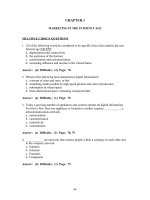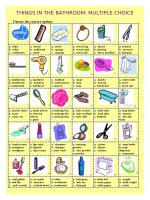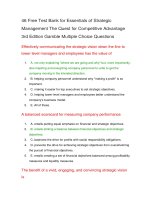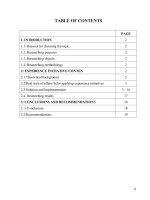Multiple Choice Identify The Choice That Best Completes The Statement Or Answers The Question..pdf
Bạn đang xem bản rút gọn của tài liệu. Xem và tải ngay bản đầy đủ của tài liệu tại đây (2.5 MB, 23 trang )
<span class="text_page_counter">Trang 1</span><div class="page_container" data-page="1">
<b>ECO111 nomicsClass: Term: Handed out: Time allowed: </b>
<b>Microeco-STUDENT INFORMATION</b>
<b> FOR TEACHER ONLY</b>
ECO_111__No__Q01Multiple Choice
Identify the choice that best completes the statement or answers the question.
QN=1 (17143) The marginal benefit John gets from eating a fourth cheeseburger at a picnic is1a. the total benefit John gets from eating four cheeseburgers minus the total benefit John
gets from eating three cheeseburgers.
b. the same as the total benefit of eating four cheeseburgers.
c. less than the marginal cost of eating the fourth cheeseburger since he chose to eat the fourth cheeseburger.
d. the total benefit John gets from eating five cheeseburgers minus the total benefit John gets from eating four cheeseburgers.
QN=2 (17122) Mitch has $100 to spend and wants to buy either a new amplifier for his guitar or a new mp3 player to listen to music while working out. Both the amplifier and the mp3 player cost $100, so he can only buy one. This illustrates the basic concept that1
<b>(NAME AND SIGNATURE)</b>
<b>Signature of Proctor</b>
</div><span class="text_page_counter">Trang 2</span><div class="page_container" data-page="2">c. rational people think at the margin.d. people respond to incentives.
QN=3 (17123) Senator Smart, who understands economic principles, is trying to convince workers in her district that trade with other countries is beneficial. Senator Smart should argue that trade can be beneficial2222
a. only if it allows us to obtain things that we couldn't make for ourselves.b. because it allows specialization, which increases total output.c. to us if we can gain and the others involved in the trade lose.
d. in only a limited number of circumstances because others are typically self-interested.
QN=4 (17136) Economics deals primarily with the concept of222
b. face many decisions.
c. must allocate the goods and services they produce.d. must have a central decision maker.
QN=6 (17130) An increase in the overall level of prices in an economy is referred to as22
c. less efficiency than would be observed in a centrally-planned economy.
d. more need for a strong legal system to control individual greed than would be needed in a centrally-planned economy.
QN=8 (17147) The invisible hand refers to2222
a. how central planners made economic decisions.
b. how the decisions of households and firms lead to desirable market outcomes.c. the control that large firms have over the economy.
d. government regulations without which the economy would be less efficient.
QN=9 (17131) Moira decides to spend two hours taking a nap rather than attending her classes. Her
</div><span class="text_page_counter">Trang 3</span><div class="page_container" data-page="3">b. the $30 she could have earned if she had worked at her job for those two hours.c. the value of her nap less the value of attending class.
d. nothing, since she would valued sleep more than attendance at class.
QN=10 (17138) Which of the following statements best represents the principle represented by the adage, "There is no such thing as a free lunch"?3
a. Melissa can attend the concert only if she takes her sister with her.b. Greg is hungry and homeless.
c. Brian must repair the tire on his bike before he can ride it to class.d. Kendra must decide between going to Colorado or Cancun for spring break.
QN=11 (17145) Suppose a typical worker in France can produce 32 units of product in an eight-hour day, while a typical worker in Germany can produce 30 units of product in a 10-hour day. We can conclude that333
a. worker productivity in Germany is higher than in France.b. the standard of living will likely be higher in France than in Germany.
c. productivity is 4 units per hour for the German worker and 3 units per hour for the French worker.
d. there will be no difference between the standard of living in France and Germany.
QN=12 (17146) Russell spends an hour studying instead of playing tennis. The opportunity cost to him of studying is333
a. the improvement in his grades from studying for the hour.
b. the improvement in his grades from studying minus the enjoyment of playing tennis.c. the enjoyment and exercise he would have received had he played tennis.
d. zero. Since Russell chose to study rather than to play tennis, the value of studying musthave been greater than the value of playing tennis.
QN=13 (17142) The term market failure refers to333
a. a situation in which the market on its own fails to allocate resources efficiently.b. an unsuccessful advertising campaign which reduces demand for a product.c. a situation in which competition among firms becomes ruthless.d. a firm which is forced out of business because of losses.
QN=14 (17117) In considering how to allocate its scarce resources among its various members, a household considers3333
a. (i) each member’s abilities.b. (ii) each member’s efforts.c. (iii) each member’s desires.d. all of (i), (ii), and (iii).
QN=15 (17134) The term used to describe a situation in which markets do not allocate resources ciently is3
b. market failure.
</div><span class="text_page_counter">Trang 4</span><div class="page_container" data-page="4">QN=16 (17114) Communist countries worked on the premise that economic well-being could be best attained by4444
b. a strong reliance on prices and individuals’ self-interests.c. a system of large privately-owned firms.
d. the actions of government central planners.
QN=17 (17120) Productivity is defined as the44
a. amount of goods and services produced from each unit of labor input.b. number of workers required to produce a given amount of goods and services.c. amount of labor that can be saved by replacing workers with machines.d. actual amount of effort workers put into an hour of working time.
QN=18 (17116) To promote good economic outcomes, policymakers should strive to enact policies that4444
a. (i) enhance productivity.
b. (ii) enhance individuals' market power.c. (iii) result in a rapidly-growing quantity of money.d. All of (i), (ii), and (iii) are correct.
QN=19 (17139) Which of the following principles is not one of the four principles of individual decision making?44
a. People face tradeoffs.
b. Trade can make everyone better off.c. People respond to incentives.d. Rational people think at the margin.
QN=20 (17127) Prices direct economic activity in a market economy by44a. influencing the actions of buyers and sellers.
b. reducing scarcity of the goods and services produced.c. eliminating the need for government intervention.
d. allocating goods and services produced in the most equitable way.
QN=21 (17121) In considering how to allocate its scarce resources among its various members, a household considers4444
a. (i) each member’s abilities.b. (ii) each member’s efforts.c. (iii) each member’s desires.d. all of (i), (ii), and (iii).
QN=22 (17129) A tradeoff exists between a clean environment and a higher level of income in that44a. studies show that individuals with higher levels of income actually pollute less than
low-income individuals.
</div><span class="text_page_counter">Trang 5</span><div class="page_container" data-page="5">c. laws that reduce pollution raise costs of production and reduce incomes.d. by employing individuals to clean up pollution, employment and income both rise.
QN=23 (17113) As a result of a successful attempt by government to cut the economic pie into more equal slices,555
a. it is easier to cut the pie, and therefore the economy can produce a larger pie.b. those who earn more income pay less in taxes.
c. the pie gets smaller, and there will be less pie overall.
d. government will spend too much time cutting and it causes the economy to lose the ability to produce enough pie for everyone.
QN=24 (17115) In a market economy, who makes the decisions that guide most economic activities?555
QN=26 (17137) The tradeoff between inflation and unemployment5
a. (i) implies that policies designed to reduce unemployment also reduce inflation.b. (ii) was eliminated by improved economic policies in the 1900s.
c. (iii) is a long-run tradeoff, persisting for decades, according to most economists.d. None of (i), (ii), and (iii) are correct.
QN=27 (17124) Most economists believe that an increase in the quantity of money results in5555a. (i) an increase in the demand for goods and services.
b. (ii) lower unemployment in the short run.c. (iii) higher inflation in the long run.d. All of (i), (ii), and (iii) are correct.
QN=28 (17125) The terms equality and efficiency are similar in that they both refer to benefits to ety. However they are different in that555
soci-a. equality refers to uniform distribution of those benefits and efficiency refers to mizing benefits from scarce resources.
maxi-b. equality refers to maximizing benefits from scarce resources and efficiency refers to uniform distribution of those benefits.
c. equality refers to everyone facing identical tradeoffs and efficiency refers to the tunity cost of the benefits.
</div><span class="text_page_counter">Trang 6</span><div class="page_container" data-page="6">oppor-QN=29 (17133) If Japan chooses to engage in trade, it6
a. will only benefit if it trades with countries that produce goods Japan cannot produce.b. cannot benefit if it trades with less developed countries.
c. should first attempt to produce the good itself.d. can benefit by trading with any other country.
QN=30 (17118) When society requires that firms reduce pollution, there is6
a. a tradeoff because of reduced incomes to the firms' owners and workers.b. a tradeoff only if some firms are forced to close.
c. no tradeoff, since the cost of reducing pollution falls only on the firms affected by the requirements.
d. no tradeoff, since everyone benefits from reduced pollution.
QN=31 (17135) The business cycle is measured by the666a. (i) production of goods and services.b. (ii) number of people employed.c. (iii) the interest rate.d. both (i) and (ii).
QN=32 (17140) The phenomenon of scarcity stems from the fact that6a. most economies’ production methods are not very good.
b. in most economies, wealthy people consume disproportionate quantities of goods and services.
c. governments restrict production of too many goods and services.d. resources are limited.
QN=33 (17119) Trade between countries tends to6666a. reduce both competition and specialization.b. reduce competition and increase specialization.c. increase competition and reduce specialization.d. increase both competition and specialization.
QN=34 (17141) Hue decides to spend three hours working overtime rather than watching a video with her friends. She earns $8 an hour. Her opportunity cost of working is666
a. the $24 she earns working.
b. the $24 minus the enjoyment she would have received from watching the video.c. the enjoyment she would have received had she watched the video.
d. nothing, since she would have received less than $24 of enjoyment from the video.
QN=35 (17132) You are considering staying in college another semester so that you can complete a jor in economics. In deciding whether or not to stay you should666
ma-a. compare the total cost of your education to the total benefits of your education.b. compare the total cost of your education to the benefits of staying one more semester.
</div><span class="text_page_counter">Trang 7</span><div class="page_container" data-page="7">d. compare the total benefits of your education to the cost of staying one more semester.
QN=36 (17173) Another term for factors of production is777
d. can be useful in helping economists understand the complex world of international trade involving many countries and many goods.
QN=38 (17184) Which of the following transactions does not take place in the markets for factors of production in the circular-flow diagram?77
a. a landowner leases land to a farmerb. a farmer hires a teenager to help with harvestc. a retired farmer sells his combine to a new farmerd. a woman buys corn for dinner
QN=39 (17156) When two variables have a positive correlation,7a. (i) when the x-variable increases, the y-variable decreases.b. (ii) when the x-variable decreases, the y-variable increases.c. (iii) when the x-variable increases, the y-variable increases.d. More than one of (i), (ii), and (iii) is correct.
QN=40 (17164) The slope of a steep upward-sloping line will be a77a. small positive number.
b. large positive number.c. small negative number.d. large negative number.
QN=41 (17160)
Refer to Figure 2-1. Which arrow shows the flow of spending by households?
</div><span class="text_page_counter">Trang 8</span><div class="page_container" data-page="8">QN=43 (17175)
Refer to Figure 2-8, Panel (a). In order to gain 2 donuts by moving from point L to point M, society must sacrifice
</div><span class="text_page_counter">Trang 9</span><div class="page_container" data-page="9">a. (i) efficiency.b. (ii) employment.c. (iii) 4 cups of coffee.
d. More than one of (i), (ii), and (iii) is correct.
QN=44 (17149) Economists sometimes give conflicting advice because9999
a. graduate students in economics are encouraged to argue with each other.b. economists have different values and scientific judgment.
c. economists acting as scientists do not like to agree with economists acting as policy visers.
ad-d. economics is more of a belief system than a science.
QN=45 (17153) The scientific method is9999
a. the use of modern technology to understand the way the world works.
b. the use of controlled laboratory experiments to understand the way the world works.c. the dispassionate development and testing of theories about how the world works.d. the search for evidence to support preconceived theories about how the world works.
</div><span class="text_page_counter">Trang 10</span><div class="page_container" data-page="10">buildings to companies in exchange for rent payments. If Malika’s income is sented by a flow of dollars from Box D to Box B of this circular-flow diagram, then Jarel’s income is represented by a flow of dollars
a. from Box A to Box C.b. from Box C to Box A.c. from Box B to Box D.d. from Box D to Box B.
QN=47 (17165) When economists make normative statements, they are10a. speaking as scientists.
b. speaking as policy advisers.c. making claims about how the world is.
d. revealing that they are very liberal in their views of how the world works.
QN=48 (17158) When economists attempt to simplify the real world and make it easier to understand they make101010
b. mistakes in judgment.
QN=49 (17148) Which of the following is not correct?1010
a. Economists use some familiar words in specialized ways.
b. Economics has its own language and its own way of thinking, but few other fields of study do.
c. Supply, demand, elasticity, comparative advantage, consumer surplus, and deadweight loss are all terms that are part of the economist’s language.
</div><span class="text_page_counter">Trang 11</span><div class="page_container" data-page="11">QN=50 (17166) The slope of a line is equal to11
a. the change in the value of x divided by the change in the value of y.b. the change in the value of y divided by the change in the value of x.c. the horizontal distance divided by the vertical distance.d. the value of y divided by the value of x.
QN=51 (17157) Suppose an economy produces two goods, food and machines. This economy always operates on its production possibilities frontier. Last year, it produced 50 units of food and 30 machines. This year it experienced a technological advance in its machine-mak-ing industry. As a result, this year the society wants to produce 55 units of food and 30 machines. Which of the following statements is correct?1111
a. Because the technological advance occurred in the machine-making industry, it will notbe possible to increase food production without reducing machine production below 30.
b. Because the technological advance occurred in the machine-making industry, increasesin output can only occur in the machine industry.
c. In order to increase food production in these circumstances without reducing machine production, the economy must reduce inefficiencies.
d. The technological advance reduced the amount of resources needed to produce 30 machines, so these resources could be used to produce more food.
QN=52 (17167) Refer to Figure 2-7. In order to reach point C, the economy would have to11111111
</div>








